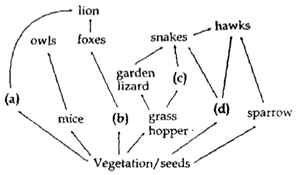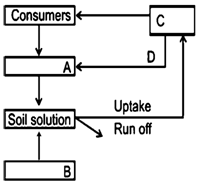The upright pyramid of number is absent in
1. Pond
2. Forest
3. Lake
4. Grassland
1. Pond
2. Forest
3. Lake
4. Grassland
Identify the likely organisms (a), (b), (c) and (d) in the food web shown below:

Options
|
(a) |
(b) |
(c) |
(d) |
|
|
1. |
deer |
rabbit |
frog |
rat |
|
2. |
dog |
squirrel |
bat |
deer |
|
3. |
rat |
dog |
tortoise |
crow |
|
4. |
squirrel |
cat |
rat |
pigeon |
The rate of formation of new organic matter by rabbits in grassland is called:
1. Net productivity
2. Secondary productivity
3. Net primary productivity
4. Gross primary productivity

To unlock all the explanations of 38 chapters you need to be enrolled in MasterClass Course.

To unlock all the explanations of 38 chapters you need to be enrolled in MasterClass Course.
The second stage of hydrosere is occupied by plants like :
1. Azolla
2.Typha
3.Salix
4. Vallisneria
Natural reservoir of phosphorus is :
1. Animal bones
2. Rock
3. Fossils
4.Sea water

To unlock all the explanations of 38 chapters you need to be enrolled in MasterClass Course.

To unlock all the explanations of 38 chapters you need to be enrolled in MasterClass Course.
Secondary productivity is rate of formation of new organic matter by:
1. Parasite
2. Consumer
3. Decomposer
4. Producer

To unlock all the explanations of 38 chapters you need to be enrolled in MasterClass Course.

To unlock all the explanations of 38 chapters you need to be enrolled in MasterClass Course.
If 20 J of energy is trapped at producer level, then how much energy will be available to peacock as food in the following chain?
plant → mice → snake → peacock
1. 0.02 J
2. 0.002 J
3. 0.2 J
4. 0.0002 J

To unlock all the explanations of 38 chapters you need to be enrolled in MasterClass Course.

To unlock all the explanations of 38 chapters you need to be enrolled in MasterClass Course.
Given below is a simplified model of phosphorus cycling in a terrestrial ecosystem with four blanks (A-D). Identify the blanks.

Options :
|
A |
B |
C |
D |
|
|
1. |
Rock minerals |
Detritus |
Litter fall |
Producers |
|
2. |
Litter |
Producers |
Rock minerals |
Detritus |
|
3. |
Detritus |
Rock minerals |
Producer |
Litter fall |
|
4. |
Producers |
Litter fall |
Rock minerals |
Detritus |

To unlock all the explanations of 38 chapters you need to be enrolled in MasterClass Course.

To unlock all the explanations of 38 chapters you need to be enrolled in MasterClass Course.
Match the following and select the correct option :
(a) Earthworm (i) Pioneer species
(b) Succession (ii) Detrivore
(c) Ecosystem service (iii) Natality
(d) Population growth (iv) Pollination
a b c d
1. (i) (ii) (iii) (iv)
2. (iv) (i) (iii) (ii)
3. (iii) (ii) (iv) (i)
4. (ii) (i) (iv) (iii)

To unlock all the explanations of 38 chapters you need to be enrolled in MasterClass Course.

To unlock all the explanations of 38 chapters you need to be enrolled in MasterClass Course.
Vertical distribution of different species occupying different levels in a biotic community is known as:
1. Stratification
2. Zonation
3. Pyramid
4. Divergence

To unlock all the explanations of 38 chapters you need to be enrolled in MasterClass Course.

To unlock all the explanations of 38 chapters you need to be enrolled in MasterClass Course.






